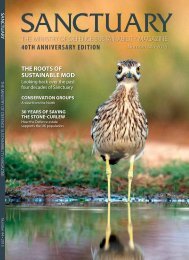SUSTAINABILITY
UC30G
UC30G
You also want an ePaper? Increase the reach of your titles
YUMPU automatically turns print PDFs into web optimized ePapers that Google loves.
FEATURES<br />
Attempting to save<br />
the Dartmoor ring ouzel<br />
pressure, where the sitting female is<br />
more likely to flush regularly and often<br />
noisily from the nest, drawing the<br />
attention of predators.<br />
One of the few Dartmoor ring ouzels © Nick Baker<br />
The ring ouzel, known as the upland<br />
blackbird, has experienced steep<br />
national declines over recent decades<br />
and is a high conservation priority. Since<br />
2010, the RSPB, supported by a range of<br />
organisations (Devon Birds, Dartmoor<br />
National Park Authority, Natural<br />
England, MOD and SITA Trust) has<br />
monitored a population on Dartmoor,<br />
at the southern edge of the species’<br />
range. Studies have found that<br />
Dartmoor’s ring ouzels have declined to<br />
a perilously low level, with just seven<br />
pairs recorded in 2013 and 2014. The<br />
birds have been observed abandoning<br />
historic nesting areas and becoming<br />
increasingly concentrated in the north<br />
west of the moor. A 2014 study<br />
concluded that the moorland owned<br />
by the MOD is now the most important<br />
area of Dartmoor for this species.<br />
western gorse, and relatively<br />
inaccessible to humans and predators,<br />
with nests well concealed in<br />
vegetation. Such areas also provided<br />
safety for vulnerable fledglings,<br />
enabling adults to feed them under<br />
cover. By contrast, nest sites that lacked<br />
this vegetation cover tended to have<br />
higher failure rates.<br />
It was also established that nest<br />
success on Dartmoor ranges between<br />
1.5–4.2 fledged chicks per pair, with<br />
predation the main cause of nest<br />
failures. Where regularly used paths<br />
follow close to nest sites, for example<br />
along water courses or at popular tors,<br />
human disturbance adds to this<br />
The conservation strategy for ring<br />
ouzels on Dartmoor is therefore to<br />
increase vegetation cover at potential<br />
nest sites to tr y and increase breeding<br />
success. Interested par ties have held<br />
discussions identif ying where shrub<br />
cover could be increased. Land<br />
owned by the MOD includes both<br />
prime habitat and areas where<br />
vegetation cover could be increased<br />
and so has formed the first trial site for<br />
habitat management.<br />
In November 2014, an MOD training<br />
exercise delivered fencing materials for<br />
local contractors to install two<br />
temporary fences, to exclude wintering<br />
livestock for five years. The fencing was<br />
funded by NE, RSPB and DB. It is hoped<br />
that these carefully sited grazing<br />
exclosures will increase vegetation<br />
height and density. The effectiveness<br />
of these exclosures will be monitored<br />
over the five years and with a view to<br />
establish similar management<br />
elsewhere on Dartmoor.<br />
Helen Booker<br />
Senior Conservation Offcer<br />
RSPB<br />
While other external factors such as<br />
climate change, migration or wintering<br />
conditions, may also be influencing the<br />
decline of Dartmoor’s ring ouzels,<br />
these factors are out of our control and<br />
therefore the RSPB has focussed on<br />
possible issues at breeding sites.<br />
The recent study importantly revealed<br />
that sites with greater breeding success<br />
were on very steep slopes, clad in<br />
deep, mature heather and bilberry, or<br />
Special delivery of fencing courtesy of the MOD © Fiona Freshney<br />
14<br />
Sanctuary 44 • 2015



